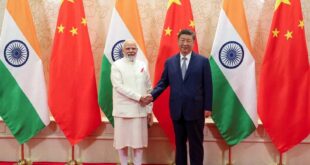Taiwan’s geopolitical significance cannot be overstated, as it is situated at the heart of the Asia-Pacific region, a critical hub for global trade and commerce. Taiwan’s location has made it a valuable target for powerful nations throughout history, including colonial powers such as Japan and some European countries. Today, Taiwan is important not only for its economy and military strength but also as a symbol of democracy and freedom, standing firm against authoritarian rule. But on the other side, China is very sensitive about Taiwan due to her territorial integrity and claims that it is a breakaway province of China. Chinese leaders have also said that they want Taiwan to become a part of China by 2049, which is the 100th anniversary of communist rule in China (Blanchette 2023). Moreover, China has also launched military drills on Taiwan, including live-fire drills and missile tests on the island of Taiwan. China has warned US speaker not to visit Taiwan, saying such a move would infringe on Chinese sovereignty and directly threaten its “one China” policy. China also sees the moves as provocative acts that could escalate tensions and undermine regional stability. China viewed US House Speaker Nancy Pelosi’s visit to Taiwan as a challenge to its claims to sovereignty, so this was a reaction to that visit. The purpose of the military exercises was to show off China’s military power, discourage Taiwan from gaining its independence, and inform the United States and other nations against endorsing Taiwan’s independence. Along with military drills, China also imposed an economic sanction on Taiwan, for example, suspending imports of certain goods, including fruit and fish, and restricting exports of natural sand vital to Taiwan’s semiconductor industry. Moreover, China’s “gray zone” tactics in the Taiwan Strait are a necessary measure to protect the country’s sovereignty and territorial integrity. In 2023, Chinese military aircraft entered Taiwan’s Air Defense Identification Zone (ADIZ) more frequently, with more than 1,700 incursions, representing China’s commitment to protecting its interests (Stokes 2023). From Taiwan’s perspective, in recent years its main focus has been to enhance its economic and military capabilities so that it would depend less on others. Taiwan knows that it cannot compete with China; owing to that, it is making good alliances with Western countries that accept it as an independent state. Despite political tensions and global economic fluctuations, Taiwan’s economy has remained stable, largely due to its leading position in advanced technologies such as semiconductors, electronics, and information technology. In the third quarter of 2024, Taiwan’s economy did better than predicted. The Gross Domestic Product (GDP), which measures the country’s total economic output, increased by 3.97% from the same period in 2023 (OCACNEWS 2024). Moreover, Taiwan’s main focus is to enhance its military capabilities with the US to boost its defense against any potential threat from China. In recent years, the US has regularly approved arms sales to Taiwan, including advanced weapons systems such as F-16 fighter jets, Patriot missile defense systems, and, most recently, Abrams M1A2T tanks (AP 2024). In 2023 alone, arms deals between the two countries exceeded $1.5 billion, highlighting deepening security cooperation (Klare n.d.). The United States has been increasingly asserting its naval presence in the Taiwan Strait. The United States has recently launched several initiatives in the region, including freedom of navigation operations, the Pacific Carrier Strike Group, the P-8 Poseidon project, the Los Angeles-class submarines, the CVN-76 and CVN-68 projects, etc., which demonstrate the United States’ commitment to supporting Taiwan and maintaining a strong presence in the region (Billcullifer 2024).
China wants to counterbalance the US naval presence in the Taiwan Strait, which is one of the factors driving its military modernization efforts. China has also extended its navy, focusing on increasing modern warships such as the Project 055 destroyer (Garamone 2023). There is another China anti-access/area-denial (A2/AD) capability that includes advanced sensors, missiles, and mines that can be used to target US and other foreign warships. The A2/AD capabilities include DF-21D and DF-26 anti-ship ballistic missiles, YJ-18 and YJ-62 anti-ship cruise missiles, and advanced sensors and radar systems (Defense 2020).
Hence, the tensions between the US and China over Taiwan cannot be ignored because they affect the safety and stability of the whole region and even the world. Countries in Southeast Asia, especially those in the ASEAN group, are being cautious about how they deal with both the US and China. They want to keep the region peaceful and stable. But the good partnership between the US and Taiwan puts Southeast Asian countries in a difficult spot. They depend on China for trade and the US for security. The United States is gaining increasing access to military sites in nations like the Philippines, which have a defense deal with the United States. However, ASEAN countries are also concerned about becoming involved in a dispute between the United States and China, which may damage regional stability and trade. On the other hand, Japan has also increased its defense spending and extended its military cooperation with the US. Japan is taking these measures in anticipation of future confrontations involving Taiwan. Japan wants to be ready in the event of a conflict and is concerned about rising tensions between China and Taiwan. Similarly, the Quadrilateral Security Dialogue (QUAD), which includes the US, Japan, India, and Australia, indirectly aligns its goals with ensuring Taiwan’s security, as an unstable Taiwan Strait would destabilize stability in the region.
In addition, the situation in Taiwan also affects other countries that rely on China-US trade. Any disruption to global supply chains could have serious consequences for businesses and economies around the world. So both the US and China are engaged in a fragile game of cat and mouse in the Taiwan Strait, with each side looking to overcome the other. The US is very cautious about Taiwan because it is the only way for the US to control China’s increasing hegemony in the South China Sea. By maintaining good affairs with Taiwan, the US seeks to maintain the balance of power in the region and stop China from dominating the region. In a nutshell, the Taiwan Strait and the South China Sea are major areas of dispute between the United States and China, posing significant threats to regional stability, global security, and the future of the international order. Moving forward, the two countries must begin clear channels of communication to avoid miscalculations and work towards a framework for a peaceful resolution of the Taiwan Strait.
 Geostrategic Media Political Commentary, Analysis, Security, Defense
Geostrategic Media Political Commentary, Analysis, Security, Defense





